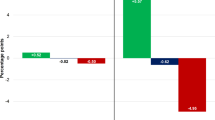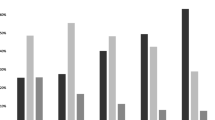Abstract
Objective: There are indications that non-medical prescription opioid analgesics use (NMPOU) in the general population has increased in Canada in recent years; however, existing estimates have limitations. Thus our objectives are to determine prevalence and associated demographics of 1) prescription opioid analgesics (PO) use, 2) NMPOU, and 3) use of PO for intoxication purposes in the adult population in Ontario.
Methods: Prevalence and the associations between sex, age, region, income, cigarette smoking, binge drinking, cannabis use and psychological distress with the above-noted types of PO use were assessed using data from the 2008 and 2009 samples (n=2030) of the CAMH Monitor. The statistical significance of the associations for all types of PO use was tested through bivariate associations using chi-square tests, and a two-step logistic regression was performed to test if demographics are associated with NMPOU.
Results: The prevalence of PO use was 21.3% (95% CI 19.1–23.4), and the prevalence of NMPOU was 2.0% (95% CI 1.2–2.8) of Ontario adults. There were no significant differences between men and women for either PO use or NMPOU. Bivariate associations indicated that NMPOU was associated with tobacco and cannabis use and psychological distress in men. Logistic regression showed a significant association between NMPOU and each of age, cannabis use, and psychological distress in men.
Discussion: NMPOU is an emerging epidemic in Canada across all income and age groups, and is associated with other substance use and mental health problems. Improved survey designs are required for more accurate population estimates of NMPOU.
Résumé
Objectif: La consommation d’analgésiques opioïdes sans ordonnance médicale (CAOSOM) semble augmenter dans la population générale depuis quelques années au Canada, mais les estimations actuelles comportent des lacunes. Nous avons voulu déterminer la prévalence et le profil démographique associé à: 1) la consommation d’analgésiques opioïdes (AO) sur ordonnance, 2) la CAOSOM et 3) la consommation d’AO à des fins d’intoxication dans la population adulte de l’Ontario.
Méthode: La prévalence et les associations entre le sexe, l’âge, la région, le revenu, l’usage de la cigarette, les excès d’alcool, l’usage du cannabis et la détresse psychologique, d’une part, et les types de consommation d’AO indiqués plus haut, ont été évaluées à l’aide des données des échantillons de 2008 et de 2009 (n=2 030) du CAMH Monitor. La signification statistique des associations pour tous les types de consommation d’AO a été testée au moyen d’associations bivariées à l’aide du test du khi-carré, et une régression logistique en deux temps a été effectuée pour tester les associations possibles des données démographiques avec la CAOSOM.
Résultats: La prévalence de la consommation d’AO était de 21,3 % (IC de 95 % 19,1–23,4), et la prévalence de la CAOSOM était de 2,0 % (IC de 95 % 1,2–2,8) chez les adultes de l’Ontario. Il n’y avait aucun écart significatif entre les hommes et les femmes, ni pour la consommation d’AO, ni pour la CAOSOM. Les associations bivariées montrent que la CAOSOM est associée à l’usage du tabac et du cannabis et à la détresse psychologique chez les hommes. La régression logistique fait état d’une association significative entre la CAOSOM et, respectivement, l’âge, l’usage du cannabis et la détresse psychologique chez les hommes.
Discussion: La CAOSOM est une épidémie émergente au Canada dans tous les groupes d’âge et de revenu; elle est associée à la consommation d’autres substances et aux problèmes de santé mentale. Il faudrait améliorer les plans de sondage pour obtenir des estimations plus exactes de la CAOSOM dans la population.
Similar content being viewed by others
References
International Narcotics Control Board. Narcotic Drugs: Estimated World Requirements for 2010–Statistics for 2008. Vienna, Austria: International Narcotics Control Board, 2010.
Fischer B, Gittins J, Rehm J. Characterizing the “awakening elephant” of prescription opioid misuse in North America: Epidemiology, harms, interventions. Contemporary Drug Problems 2008;35:397–426.
Joranson D, Gilson A. Wanted: A public health approach to prescription opi-oid abuse and diversion. Pharmacoepidemiol Drug Safety 2006;15:632–34.
Dhalla IA, Mamdani MM, Sivilotti ML, Kopp A, Qureshi O, Juurlink DN. Prescribing of opioid analgesics and related mortality before and after the introduction of long-acting oxycodone. CMAJ 2009;181:891–96.
Compton W, Volkow N. Major increases in opioid analgesic abuse in the United States: Concerns and strategies. Drug Alcohol Depend 2006;81:103–7.
Substance Abuse and Mental Health Services Administration (SAMHSA). Drug Abuse Warning Network 2006: National Estimates of Drug-Related Emergency Department Visits. Rockville, MD: SAMHSA Office of Applied Studies, 2008.
Zacny J, Bigelow G, Compton P, Foley K, Iguchi M, Sannerud C. College on Problems of Drug Dependence taskforce on prescription opioid non-medical use and abuse: Position statement. Drug Alcohol Depend 2003;69:215–32.
Popova S, Rehm J, Fischer B. An overview of illegal opioid use and health services utilization in Canada. Public Health 2006;120:320–28.
Popova S, Patra J, Mohapatra S, Fischer B, Rehm J. How many people in Canada use prescription opioids non-medically in general and street drug-using populations? Can J Public Health 2009;100:104–8.
Fischer B, Rehm J. Deaths related to the use of prescription opioids. CMAJ 2009;181:881–82.
Canadian Alcohol and Drug Use Monitoring Survey. 2008.
Fischer B, Nakamura N, Ialomiteanu A, Boak A, Rehm J. Assessing the prevalence of non-medical prescription opioid use in the general Canadian population: Methodological issues and questions. Can J Psychiatry 2010;55:606–9.
Substance Abuse and Mental Health Services Administration (SAMHSA). Results from the 2008 National Survey on Drug Use and Health: National Findings. Rockville: SAMHSA Office of Applied Studies, 2009.
Zhao J, Stockwell T, Macdonald S. Non-response bias in alcohol and drug population surveys. Drug and Alcohol Rev 2009;28:648–57.
Sudman S, Bradburn N, Schwarz N. Thinking About Answers: The Application of Cognitive Processes to Survey Methodology. San Francisco, CA: Jossey-Bass, 1996.
Health Canada. Canadian Alcohol and Drug Use Monitoring Survey 2008: Microdata User Guide. 2009. Available at: http://www.prod.library.utoronto.ca/datalib/codebooks/cstdli/cadums/2008/cadums-technical-guide-2008-final-eng.pdf (Accessed August 20, 2010).
Ialomiteanu A, Adlaf E. CAMH Monitor 2009 Technical Guide. Toronto: Centre for Addiction and Mental Health, 2010. Available at: http://www.camh.net/Research/camh_monitor.html (Accessed August 20, 2010).
Ialomiteanu A, Adlaf E. CAMH Monitor 2008 Technical Guide. Toronto: Centre for Addiction and Mental Health, 2009. Available at: http://www.camh.net/Research/camh_monitor.html (Accessed August 20, 2010).
Goldberg D P, Hillier V F. A scaled version of the General Health Questionnaire. Psychol Med 1979;9:139–45.
Stata Corporation. Statistical Software: Release 11.0. College Station, TX: Stata Corporation, 2001.
SPSS Inc. SPSS Statistics, Release Version 15.0.0. Chicago, IL: SPSS Inc., 2006.
Binder DA. On the variances of asymptotically normal estimators from complex surveys. Int Statistical Rev 1983;51:279–92.
Hosmer DW, Lemeshow S. Goodness-of-fit tests for the multiple logistic regression model. Communications in Statistics: Theory and Methods 1980;9(10):1043–69.
Groves R. Survey Errors and Survey Costs. Errors in Survey Costs. New York: Wiley, 1989.
Colliver JD, Kroutil LA, Dai L, Gfroerer JC. Misuse of Prescription Drugs: Data From the 2002, 2003 and 2004 National Surveys on Drug Use and Health. Rockville: Substance Abuse and Mental Health Services Administration, Office of Applied Studies, 2006.
Back SE, Payne RL, Simpson AN, Brady KT. Gender and prescription opioids: Findings from the National Survey on Drug Use and Health. Addict Behav 2010;35:1001–7.
Back SE, Lawson KM, Singleton LM, Brady KT. Characteristics and correlates of men and women with prescription opioid dependence. Addict Behav 2011;36:829–34.
Tetrault JM, Desai RA, Becker WC, Fiellin DA, Concato J, Sullivan LE. Gender and non-medical use of prescription opioids: Results from a national US survey. Addiction 2008;103:258–68.
Simoni-Wastila L. The use of abusable prescription drugs: The role of gender. J Women’s Health Gender-Based Med 2000;9:289–97.
Simoni-Wastila L. Gender and other factors associated with the nonmedical use of abusable prescription drugs. Subst Use Misuse 2004;39:1–23.
Huang B, Dawson DA, Stinson FS, Hasin DS, Ruan WJ, Saha TD, et al. Prevalence, correlates, and comorbidity of nonmedical prescription drug use and drug use disorders in the United States: Results of the National Epidemiolog-ic Survey on Alcohol and Related Conditions. J Clin Psychiatry 2006;67:1062–73.
Martins SS, Keyes KM, Storr CL, Zhu H, Chilcoat HD. Pathways between non-medical opioid use/dependence and psychiatric disorders: Results from the National Epidemiologic Survey on Alcohol and Related Conditions. Drug Alcohol Depend 2009;103:16–24.
Dowling K, Storr CL, Chilcoat HD. Potential influences on initiation and persistence of extramedical prescription pain reliever use in the US population. Clin J Pain 2006;22:776–83.
Babor TF, Caulkins JP, Edwards G, Fischer B, Foxcroft DR, Humphreys K, et al. Drug Policy and the Public Good. Oxford, United Kingdom: Oxford University Press, 2010.
Author information
Authors and Affiliations
Corresponding author
Additional information
Sources of Funding: Drs. Fischer and Rehm acknowledge funding support from a CIHR Team Grant (#SAF195814) as well as from the Ontario Ministry of Health and Long-Term Care. Dr. Fischer acknowledges support from a CIHR/PHAC Research Chair in Applied Public Health (#CPP85657), and from a Michael Smith Foundation for Health Research (MSFHR) Senior Scholar Award.
Conflict of Interest: None to declare.
Rights and permissions
About this article
Cite this article
Shield, K.D., Ialomiteanu, A., Fischer, B. et al. Non-medical Use of Prescription Opioids Among Ontario Adults: Data From the 2008/2009 CAMH Monitor. Can J Public Health 102, 330–335 (2011). https://doi.org/10.1007/BF03404171
Received:
Accepted:
Published:
Issue Date:
DOI: https://doi.org/10.1007/BF03404171




